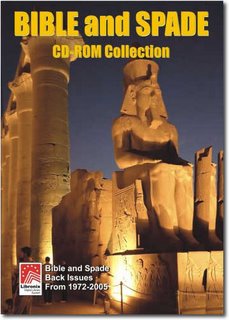 The most popular archaeology magazine for biblical discoveries is Biblical Archaeology Review. Another magazine that covers similar topics is Bible and Spade. Produced by the Associates for Biblical Research and edited by Dr. Bryant G. Wood, Bible and Spade has a much more conservative perspective than BAR. I recommend a subscription (sample pdf issue here).
The most popular archaeology magazine for biblical discoveries is Biblical Archaeology Review. Another magazine that covers similar topics is Bible and Spade. Produced by the Associates for Biblical Research and edited by Dr. Bryant G. Wood, Bible and Spade has a much more conservative perspective than BAR. I recommend a subscription (sample pdf issue here).
This week Galaxie Software announced an electronic collection of all back issues of Bible and Spade. All 31 years (1972-2005) are available for $80, but until July 31, there is a special of $50.
So for the cost of a 3-year subscription, you get all 31 years. And the electronic edition is of course much better. To get the deal you have to order it from this page and enter code 5454. Not later than July 31.